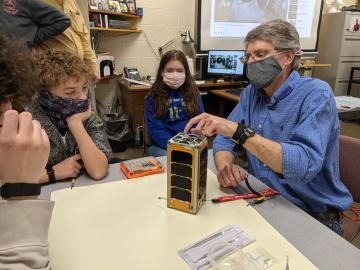
Filter News
Area of Research
- (-) Biological Systems (2)
- (-) Electricity and Smart Grid (2)
- (-) Materials (38)
- (-) Supercomputing (42)
- Advanced Manufacturing (3)
- Biology and Environment (99)
- Biology and Soft Matter (1)
- Computational Engineering (1)
- Computer Science (3)
- Energy Science (85)
- Fusion and Fission (4)
- Fusion Energy (1)
- Isotopes (3)
- Materials for Computing (9)
- Mathematics (1)
- National Security (12)
- Neutron Science (13)
- Nuclear Science and Technology (7)
- Quantum information Science (3)
- Sensors and Controls (1)
News Type
News Topics
- (-) Bioenergy (8)
- (-) Composites (6)
- (-) Environment (28)
- (-) Frontier (18)
- (-) Grid (5)
- (-) Microscopy (13)
- (-) Molten Salt (1)
- (-) Nanotechnology (17)
- (-) Space Exploration (4)
- 3-D Printing/Advanced Manufacturing (11)
- Advanced Reactors (3)
- Artificial Intelligence (23)
- Big Data (20)
- Biology (8)
- Biomedical (15)
- Biotechnology (1)
- Buildings (4)
- Chemical Sciences (11)
- Clean Water (3)
- Computer Science (65)
- Coronavirus (10)
- Critical Materials (7)
- Cybersecurity (2)
- Energy Storage (15)
- Exascale Computing (17)
- Fusion (5)
- High-Performance Computing (28)
- Isotopes (9)
- Machine Learning (9)
- Materials (33)
- Materials Science (39)
- Mathematics (2)
- Microelectronics (1)
- National Security (3)
- Neutron Science (18)
- Nuclear Energy (15)
- Partnerships (3)
- Physics (15)
- Polymers (11)
- Quantum Computing (16)
- Quantum Science (15)
- Security (3)
- Simulation (13)
- Software (1)
- Summit (28)
- Transportation (14)
Media Contacts

An international problem like climate change needs solutions that cross boundaries, both on maps and among disciplines. Oak Ridge National Laboratory computational scientist Deeksha Rastogi embodies that approach.

Improved data, models and analyses from ORNL scientists and many other researchers in the latest global climate assessment report provide new levels of certainty about what the future holds for the planet

RamSat’s mission is to take pictures of the forests around Gatlinburg, which were destroyed by wildfire in 2016. The mission is wholly designed and carried out by students, teachers and mentors, with support from numerous organizations, including Oak Ridge National Laboratory.

At the Department of Energy’s Oak Ridge National Laboratory, scientists use artificial intelligence, or AI, to accelerate the discovery and development of materials for energy and information technologies.

A method developed at Oak Ridge National Laboratory to print high-fidelity, passive sensors for energy applications can reduce the cost of monitoring critical power grid assets.

Twenty-seven ORNL researchers Zoomed into 11 middle schools across Tennessee during the annual Engineers Week in February. East Tennessee schools throughout Oak Ridge and Roane, Sevier, Blount and Loudon counties participated, with three West Tennessee schools joining in.

On Feb. 18, the world will be watching as NASA’s Perseverance rover makes its final descent into Jezero Crater on the surface of Mars. Mars 2020 is the first NASA mission that uses plutonium-238 produced at the Department of Energy’s Oak Ridge National Laboratory.

The U.S. Air Force and Oak Ridge National Laboratory launched a new high-performance weather forecasting computer system that will provide a platform for some of the most advanced weather modeling in the world.

A new tool from Oak Ridge National Laboratory can help planners, emergency responders and scientists visualize how flood waters will spread for any scenario and terrain.



